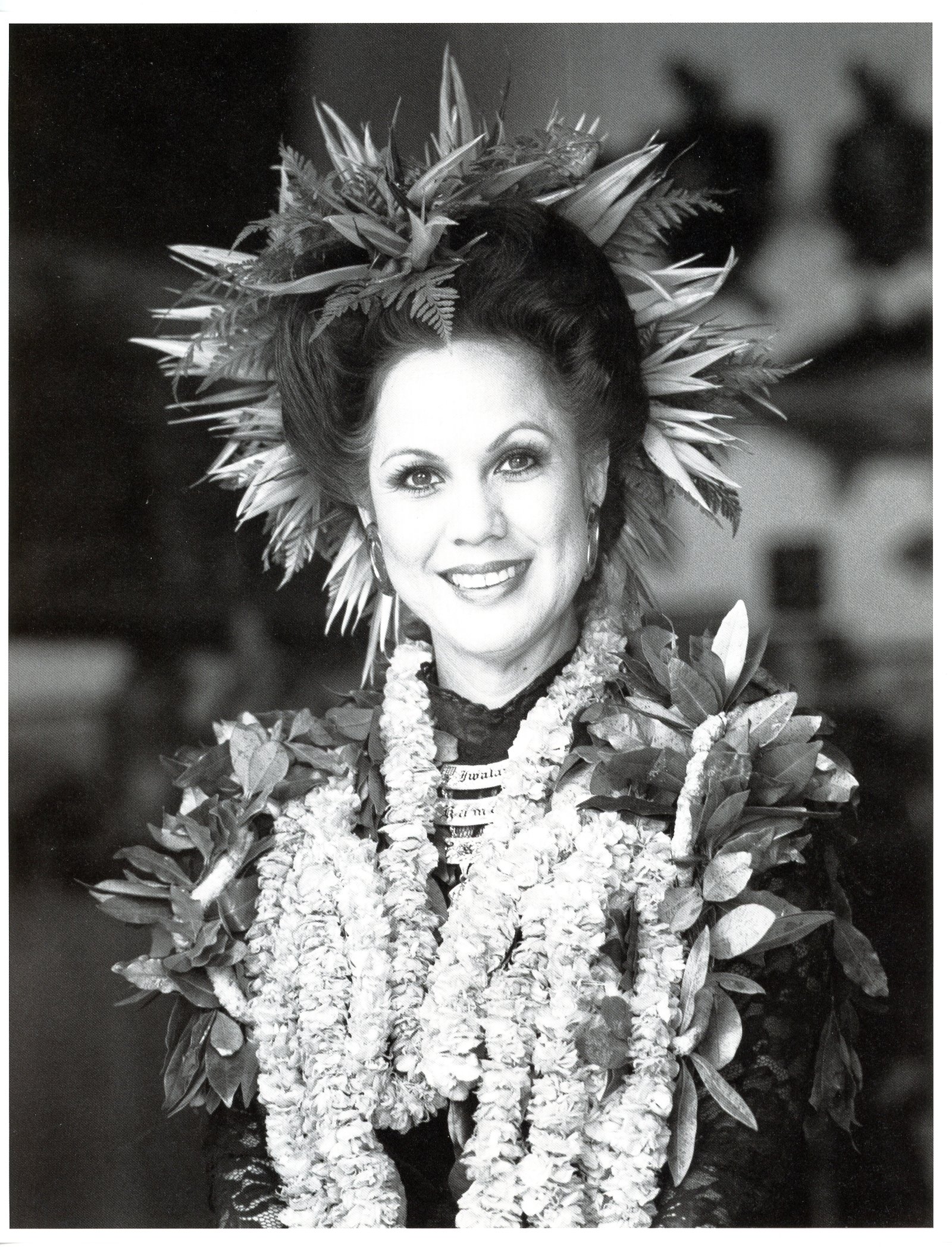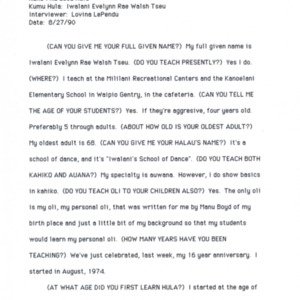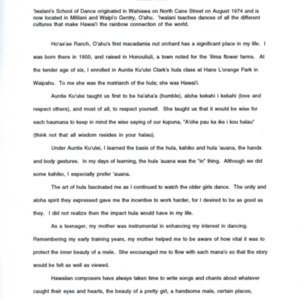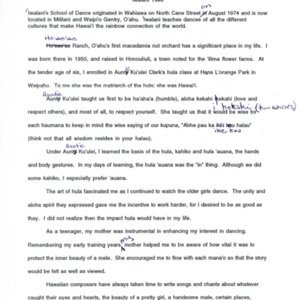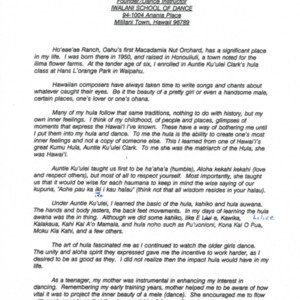‘Iwalani Tseu
Title
‘Iwalani Tseu
Subject
Nā Kumu Hula ‘Iwalani Tseu - Nānā I Nā Loea Hula Volume 2 Page 112
Description
‘Iwalani’s School of Dance originated in Wahiawa on August 1974 and is now located in Mililani and Waipi‘o Gentry; O‘ahu.
Hō‘ae‘ae Ranch, O‘ahu’s first macadamia nut orchard has a significant place in my life. I was born there in 1950 and raised in Honouliuli, a town noted for its ‘ilima flower farms. At the age of six I enrolled in Auntie Ku‘ulei Clark's hula class at Hans LʻOrange Park in Waipahū. To me she was the matriarch of the hula; she was Hawaiʻi.
Auntie Ku'ulei taught us first to be ha‘aha‘a (humble), aloha kekahi i kekahi (love and respect each other), and most of all, to respect yourself. She taught us that it would be wise for each haumāna to keep in mind the wise saying of our kupuna, “A‘ohe pau ka ʻike i kāu hālau" (think not that all wisdom resides in your hālau). Under Auntie Kuʻulei l learned the basics of the hula kahiko and hula ‘auana. In my days of learning, hula ʻauana was popular. Although we did some kahiko, I prefer ‘auana.
The art of hula fascinated me as I watched the older girls dance. The unity and aloha they expressed gave me the incentive to work harder for I wanted to be as good as they were. My mother helped me to be aware of how vital it was to protect the inner beauty of a mele. She encouraged me to flow with each mana‘o so that the story could be felt as well as viewed.
I became a professional dancer and traveled to the mainland and all over the world. I was offered to do a two-week promotion for American President Lines on the passenger liner steamship, President Cleveland. This promotion developed into a commitment which lasted nearly three years. Traveling to exotic countries brought rewarding memories and an opportunity to share our Hawaiian culture.
Hawaiian composers have always taken time to write songs and chants about whatever caught their eyes and hearts: the beauty of a pretty girl, a handsome male, flowers, lovers or ‘ohana. Many of my hula follow the same tradition. I think of my childhood, of people and places, glimpses of moments that express the Hawai‘i I’ve known. To me the hula is the ability to express one’s most inner feelings. It should not be a copy of someone else.
Today I’m still seeking more knowledge. I’m fortunate to have mentors such as Kimo Alania Keaulana who unselfishly continues to share his expertise and mana‘o with me, and Uncle George Nā‘ope who inspires and guides me.
The art of hula is recognized throughout the world for it is a dance form as well as the history of our kupuna. Their mana‘o is transformed within our body through songs and dances as a way of expressing our cultural heritage. This is the wealth of our Hawaiian Islands which make us so unique. This is the true meaning of aloha.
Hō‘ae‘ae Ranch, O‘ahu’s first macadamia nut orchard has a significant place in my life. I was born there in 1950 and raised in Honouliuli, a town noted for its ‘ilima flower farms. At the age of six I enrolled in Auntie Ku‘ulei Clark's hula class at Hans LʻOrange Park in Waipahū. To me she was the matriarch of the hula; she was Hawaiʻi.
Auntie Ku'ulei taught us first to be ha‘aha‘a (humble), aloha kekahi i kekahi (love and respect each other), and most of all, to respect yourself. She taught us that it would be wise for each haumāna to keep in mind the wise saying of our kupuna, “A‘ohe pau ka ʻike i kāu hālau" (think not that all wisdom resides in your hālau). Under Auntie Kuʻulei l learned the basics of the hula kahiko and hula ‘auana. In my days of learning, hula ʻauana was popular. Although we did some kahiko, I prefer ‘auana.
The art of hula fascinated me as I watched the older girls dance. The unity and aloha they expressed gave me the incentive to work harder for I wanted to be as good as they were. My mother helped me to be aware of how vital it was to protect the inner beauty of a mele. She encouraged me to flow with each mana‘o so that the story could be felt as well as viewed.
I became a professional dancer and traveled to the mainland and all over the world. I was offered to do a two-week promotion for American President Lines on the passenger liner steamship, President Cleveland. This promotion developed into a commitment which lasted nearly three years. Traveling to exotic countries brought rewarding memories and an opportunity to share our Hawaiian culture.
Hawaiian composers have always taken time to write songs and chants about whatever caught their eyes and hearts: the beauty of a pretty girl, a handsome male, flowers, lovers or ‘ohana. Many of my hula follow the same tradition. I think of my childhood, of people and places, glimpses of moments that express the Hawai‘i I’ve known. To me the hula is the ability to express one’s most inner feelings. It should not be a copy of someone else.
Today I’m still seeking more knowledge. I’m fortunate to have mentors such as Kimo Alania Keaulana who unselfishly continues to share his expertise and mana‘o with me, and Uncle George Nā‘ope who inspires and guides me.
The art of hula is recognized throughout the world for it is a dance form as well as the history of our kupuna. Their mana‘o is transformed within our body through songs and dances as a way of expressing our cultural heritage. This is the wealth of our Hawaiian Islands which make us so unique. This is the true meaning of aloha.
Citation
“‘Iwalani Tseu,” Nā Kumu Hula Archive, accessed August 25, 2025, https://nakumuhula.org/archive/items/show/154.



